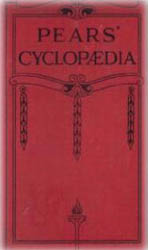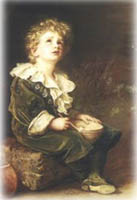[wp_ad_camp_1]
The 56th edition of the Pears’ Cyclopadia – the War Economy Issue – had the following blurb quaintly sitting on its inside page: “This book is not published annually, but as demand requires. Current matter is revised for each edition.”

I’m sure all my English readers, and maybe some Aussies, will know about the Pears’ Cyclopaedia. For my American friends – Pears is a soap which was first manufactured way back in the 19th century. It’s a transparent amber oval bar so not only looks but also smells quite unique.
Pears Soap launched the Pears’ Shilling Cyclopaedia, in December 1897 and it’s still going strong today! It’s basically a one volume encyclopedia published in the UK and the trademark seems to be a painting by Sir John Millais Bart entitled “Bubbles” on the inside front cover. The model for ‘Bubbles’ was the artist’s grandson, Willie (later Admiral Sir William) James.

Anyway, to cut a long story short. I flicked through the Cyclopaedia to see if they had any reference to ferrets (what else?) and sure enough, they did.
When you read how it was recommended that ferrets were fed or kept, it makes you wonder how the breed survived! Feeding the poor animals “mush” and keeping them in straw or wood shavings! Good heavens! Interestingly enough, the ‘Cyclopaedia’ says that ferrets “do not exist in England in a condition of natural freedom” so that’s put paid to any reference of feral ferrets, wouldn’t you say?
CDFG — please take note! The English ferret is considered a …(gasp) …. DOMESTIC PET!!!!!
Anyway, as old as it is, I thought the information was well worth sharing! 
Under the heading General Information
Ferret, a carnivorous animal of the Pole-cat family, with a pointed head and long sinuous body, well adapted for following rabbits and game into their burrows and hiding-places, it being kept in this country for that purpose. It is a native of Spain and Africa, and does not exist in England in a condition of natural freedom.
Under the heading Domestic Pets
FERRETS
Description. — The ferret is a domestic form of the continental polecat and was probably introduced to England six hundred years ago. There are two main varieties – albinos, with yellow-white fur and pink eyes, and “polecat ferrets”, dark brown in colour, which resemble their wild ancestors very closely. Ferrets are widely kept for hunting rats and rabbits.
Food.— In our opinion, it is best to give each ferret, daily, as much bread and milk as will be eaten up promptly and completely by the animal. Alternatively, a mush made from whole wheat flour and water can be given. Most people think that salt is bad for ferrets, but there is no harm in having under one per cent in the diet. Besides bread and milk or mush, about four ozs. Of meat could be given two or three times a week. Liver is very good. Over-feeding must be avoided. Young ferrets need more meals, and should be given three daily after weaning, then two, and only one when fully adult.
Housing. — Ferrets are very clean, and do well in cages one foot high by two feet long by one and a half feet. Hay, or better, wood shavings for litter – replace this every two days and clean out the whole cage weekly. Ferrets do best out of doors, provided their house-box is sheltered and their run is shaded from summer sunlight. The run need not be more than three feet by two feet if you are keeping your ferrets for working as a ratter or rabbiter.
Breeding. — A female ferret comes in season for the first time early in March of the year following birth, and if it then is mated and gives birth to a litter, it will have a second season in autumn. The gestation period is about forty-two days, so that litters usually appear in May and September. Six to eight young are most usual, and before the litter is due, the female should be provided with straw for a nest. The young open their eyes only after four weeks, and can then be given a little bread and milk. Of course during suckling the mother should be given plenty of milk.
Handling. — Ferrets should not be difficult to tame; if they are not yet tame they should be handled as follows. Attract the ferret’s attention with the left hand, and with the right grasp it quickly by the tail when its back is turned. It can be then quickly lifted, and the first and second figures of the left hand should immediately grasp the neck just behind the ears. The thumb and other fingers are then able to restrain the fore legs, while the right hand can then let go of the tail and grasp the hind quarters and legs. If bitten by a ferret when handling, let go of it and the ferret will let go of you.
Diseases. — The worst ferret disease is distemper(the same disease as that in dogs), and it is extremely difficult to treat. Ferrets suffer also from mange caused by a mite, scabies, ear canker, boils and pneumonia. Distemper is almost impossible to deal with, and a merciful release may be the best end after you have consulted a veterinarian. Most of the other diseases can be prevented by cleanliness and proper dryness and ventilation. Mange scabs should be removed with forceps, and the affected part smeared with xlylol. After this use cleansing ointment. Scabies can be best treated with oil and sulphur; ear-canker with ear-drops containing carbolic and tannic acid.
[wp_ad_camp_3]
Return from Ferrets in the Pears Cyclopaedia to All About Ferrets

Deprecated: str_contains(): Passing null to parameter #1 ($haystack) of type string is deprecated in /home4/kitchast/public_html/wp-includes/comment-template.php on line 2681